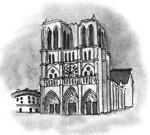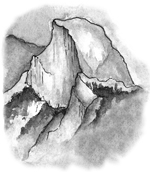The Way of Wanderlust (7 page)

I love the place partly because it is so emphatically not a ten-minute tourist stop. Its dimensions defy the cameraâI have never seen a true picture of the placeâand its subtle simplicity defies quick assimilation. It makes you sit and study, slow down and stare until you really see itâ in its particularity and in its whole, simultaneously.
And yetâand here the enigma expandsâyou cannot see all of Ryoanji at one time: The rocks are so arranged that you can see only fourteen of the stones wherever you stand. You have to visualize, imagine, the final one.
How wonderful! It is in this sense that Ryoanji is, for me, the essential sacred place: It is complete in itself, but for you to completely perceive it, you have to transcend the boundary between inner and outerâto travel inward as well as outward, to find and finish it in your mind.
And the gigglers, the camera-clickers, and the squawking loudspeakers are all, in their exasperating reality, part of this completion. Beyond a great irony of modern Japanâloudspeakers instructing you to appreciate the silenceâthey embody a much larger meaning: You must embrace them allâthe monks and the moss and the trees, the schoolkids and the stonesâto really be there, to be whole.
![]()
A Moment at Notre-Dame

After I became Travel Editor at the
Examiner,
my first trip was a pilgrimage to Paris. That was a glorious re-immersion in and celebration of poignant places from my past, and the most poignant of all was Notre-Dame Cathedral. Notre-Dame is one of the planet's touchstone places for me, and this essay was, in a sense, an attempt to stop time: to focus on a remembered moment in a place, and to dive archaeologically into the imaginative and emotional layers of that moment. I was intensely surprised and stirred by the layers that excavation revealed.
![]()
NOTRE-DAME FROM THE OUTSIDE IS MAGNIFICENT,
monumental, solidly of the earth and yet soaringly not. But for all its monumental permanence, its context is clearly the present: Visitors pose, focus, click; portable stalls sell sandwiches and postcards; tourist groups shuffle by in ragtag formation.
Walk through those massive, humbling doors, though, and suddenly you breathe the air of antiquity. Let your mind and eyes adjust to the inner light, and you begin to realize that there is much more to Paris than the life of its streets, and a small sense of its magnificent and moving past comes back to you.
When I entered Notre-Dame on my most recent trip, I was overwhelmed by the solid, soaring arches and columns I had forgotten, by the depth and texture of the stained-glass windows with their luminous blues and reds and greens. I thought of how many people had worked to build this magnificence, and of how many people since then had stood, perhaps on the very same stones as I, and marveled at it. I thought of all the faith and hope and sacrifice it manifests.
I walked through the fervent space, awed by the art and the hush that seemed to resonate with the whispers of centuries, and just when I was beginning to feel too small and insignificant and was getting ready to leave, I saw a simple sign over a tiny stone basin of water, on a column near the doors.
The sign said, “In the name of the father and the son and the Holy Spirit” in seven languages, with pictures that showed a hand dipping into the water, then touching a forehead.
I touched my hand to the cool, still water, then brought it to my head, and as I did so, chills ran through my body and tears streamed into my eyes.
Somehow that simple act had forged a palpable contact with ages past, had put everything into startling focus: the ceaseless flow of pilgrims to this special place, the ceaseless procession of hands to water and fingers to forehead, all sharing this basin, this gesture.
I felt a new sense of the history that flows with us and around us and beyond us allâof the plodding, tireless path of humankind and of the sluggish, often violent spread of Christianity through Europe and the rest of the worldâand a new sense of the flow of my own history, too: my Protestant upbringing, a pastor whose notions of Christian love have had a deep and abiding influence on my life, the old and still inconceivable idea of God.
For a few moments I lost all sense of place and timeâthen a door opened and a tourist group entered, looking up and around in wonder, and I walked into the world of sunlight and spire again.
I stopped, blinked at the sandwich stalls and postcard vendors, then turned back toward that stony symmetry and thought: Sometimes you feel so small and insignificant in the crush of history that you lose all sense of purpose and self. Then something will happen to make you realize that every act and every encounter has its own precious meaning and lesson, and that history is simply the sum of all these.
Sometimes it comes together, as it did for me that moment in Notre-Dame; sometimes the world is reduced to a simple sign, a stone basin, the touch of water to headâand the vast pageant of the past and the living parade of the present take on a new, and renewing, symmetry and sense.
![]()

In the mid-1990s, I left the
Examiner
and joined Salon, a feisty, bright, and ambitious web magazine that had been started by friends and colleagues from the
Examiner
. The founders' goal was to produce a site distinguished by intelligent commentary, excellent writing, and groundbreaking journalism, and within that context, they asked me to create the travel section of my dreams. I christened the section Wanderlust, and we launched in 1997, with the passionate mandate of publishing unvarnished dispatches and soul-stretching narratives. “Conquering Half Dome,” published in 1999, was my own attempt to write a soul-stretching narrative about an adventure not far from my Northern California backyard, in Yosemite National Park, but threaded with far-ranging themes of frailty, family, and overcoming our fears. When I read this now, I can't help but compare the narrator of this piece with the heedless young man who ascended Kilimanjaro on a whim. . . . And I think: Our mountains also evolve over time.
![]()
SOMETIMES WE KNOW A JOURNEY WILL BE
a grand adventureâthe three-week expedition I made along Pakistan's avalanche-laden Karakoram Highway to enchanted Hunza comes to mind. Other times we know it will be a little oneâon a recent quick business trip to Paris I was content with stumbling upon a wonderful ancient restaurant and a precious new park I'd never known about.
But sometimes our trips surprise us.
In the summer of 1999, my family made a five-day excursion to Yosemite. It was supposed to be a little camping lark, but it turned out to be a much granderâand much more terrifyingâadventure than I'd ever imagined.
The trip seemed innocent enough: Our plan was to drive to Yosemite on a Saturday, spend the next three days camping and hiking to the top of Half Dome, then hike back to our car and drive home on the fifth day. This would require three days of four to six hours of hiking. The only moderately troublesome part would be the final ascent of Half Dome, that iconic granite thumb that juts almost 9,000 feet over the meadows and waterfalls and lesser crags of California's Yosemite Valley. But I had seen pictures of the cable-framed walkway that leads to the top of the mountain, and it didn't look too difficult. My wife and I felt confident that our eight-year-old son and twelve-year-old daughter could handle it.
So off we went. We made the winding drive from the San Francisco Bay Area to Yosemite National Park in about four hours. It was a splendid day, all cotton-candy clouds against a county-fair sky. Eating carrots and apple slices in the car, we sped through the suburbs and into parched golden hills, and before we knew it we were off the main highway and passing hand-painted signs advertising red onions, fresh-picked tomatoes, almonds, peaches, and nectarines. Our eyes lingered on the weather-beaten stands, where we could see shiny red mounds of tomatoes and green mountains of watermelons, but we pressed on.
We reached Yosemite as the sun was setting, picked up our trail permit, pitched our tent, cooked a quick camp supper, and went to bed.
Our plan was to get up early, hike more than halfway upâto the highest source of water on the Half Dome trailâand camp, thereby minimizing the distance we would have to cover the next day before making our assault on the peak. If you're young and strong, or old and foolhardy, you can hike from Yosemite Valley to the top of Half Dome and back in a day. In previous trips to Yosemite we had met people who had done just that; they would leave at daybreak and plan to get back around dusk. But we wanted to take it easy on ourselves. We also had built in an extra day so that if for any reason we couldn't make Half Dome the first time, we would have a second chance, so we weren't in any hurry.
